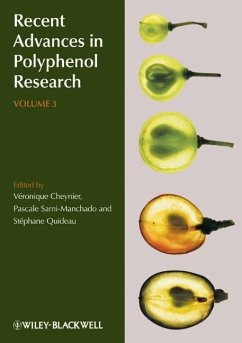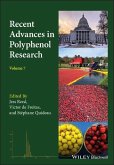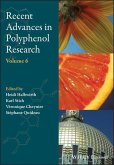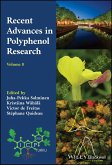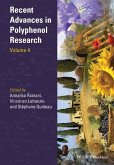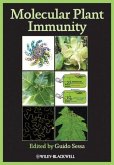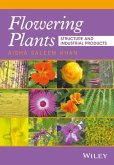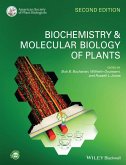Recent Advances in Polyphenol Research, Volume 3
Herausgegeben von Cheynier, Véronique; Sarni-Manchado, Pascale; Quideau, Stéphane
Recent Advances in Polyphenol Research, Volume 3
Herausgegeben von Cheynier, Véronique; Sarni-Manchado, Pascale; Quideau, Stéphane
- Gebundenes Buch
- Merkliste
- Auf die Merkliste
- Bewerten Bewerten
- Teilen
- Produkt teilen
- Produkterinnerung
- Produkterinnerung
Plant polyphenols are secondary metabolites that constitute one of the most common and widespread groups of natural products. They express a large and diverse panel of biological activities including beneficial effects on both plants and humans. Many polyphenols, from their structurally simplest representatives to their oligo/polymeric versions (also referred to as vegetable tannins) are notably known as phytoestrogens, plant pigments, potent antioxidants, and protein interacting agents.
Sponsored by Groupe Polyphénols, this publication, which is the third volume in this highly regarded…mehr
Andere Kunden interessierten sich auch für
![Recent Advances in Polyphenol Research, Volume 7 Recent Advances in Polyphenol Research, Volume 7]() Recent Advances in Polyphenol Research, Volume 7214,99 €
Recent Advances in Polyphenol Research, Volume 7214,99 €![Recent Advances in Polyphenol Research, Volume 6 Recent Advances in Polyphenol Research, Volume 6]() Recent Advances in Polyphenol Research, Volume 6247,99 €
Recent Advances in Polyphenol Research, Volume 6247,99 €![Recent Advances in Polyphenol Research, Volume 8 Recent Advances in Polyphenol Research, Volume 8]() Recent Advances in Polyphenol Research, Volume 8218,99 €
Recent Advances in Polyphenol Research, Volume 8218,99 €![Recent Advances in Polyphenol Research, Volume 4 Recent Advances in Polyphenol Research, Volume 4]() Recent Advances in Polyphenol Research, Volume 4262,99 €
Recent Advances in Polyphenol Research, Volume 4262,99 €![Molecular Plant Immunity Molecular Plant Immunity]() Molecular Plant Immunity202,99 €
Molecular Plant Immunity202,99 €![Flowering Plants Flowering Plants]() Aisha S. KhanFlowering Plants211,99 €
Aisha S. KhanFlowering Plants211,99 €![Biochemistry and Molecular Biology of Plants Biochemistry and Molecular Biology of Plants]() Biochemistry and Molecular Biology of Plants130,99 €
Biochemistry and Molecular Biology of Plants130,99 €-
-
-
Plant polyphenols are secondary metabolites that constitute one of the most common and widespread groups of natural products. They express a large and diverse panel of biological activities including beneficial effects on both plants and humans. Many polyphenols, from their structurally simplest representatives to their oligo/polymeric versions (also referred to as vegetable tannins) are notably known as phytoestrogens, plant pigments, potent antioxidants, and protein interacting agents.
Sponsored by Groupe Polyphénols, this publication, which is the third volume in this highly regarded Recent Advances in Polyphenol Research series, is edited by Véronique Cheynier, Pascale Sarni-Manchado, and Stéphane Quideau (the current President of Groupe Polyphénols). Like their predecessors, they have once again put together an impressive collection of cutting-edge chapters written by expert scientists internationally respected in their respective field of polyphenol sciences. This Volume 3 provides the latest information and opinion on the following major research topics about polyphenols:
Organic chemistry and physical chemistry
Biosynthesis, genetics and metabolic engineering
The role of polyphenols in plants and ecosystems
Health and nutrition
Analysis and metabolomics
Chemists, biochemists, plant scientists, pharmacognosists and pharmacologists, biologists, ecologists, food scientists and nutritionists will all find this book an invaluable resource. Libraries in all universities and research institutions where these disciplines are studied and taught should have copies on their bookshelves.
Hinweis: Dieser Artikel kann nur an eine deutsche Lieferadresse ausgeliefert werden.
Sponsored by Groupe Polyphénols, this publication, which is the third volume in this highly regarded Recent Advances in Polyphenol Research series, is edited by Véronique Cheynier, Pascale Sarni-Manchado, and Stéphane Quideau (the current President of Groupe Polyphénols). Like their predecessors, they have once again put together an impressive collection of cutting-edge chapters written by expert scientists internationally respected in their respective field of polyphenol sciences. This Volume 3 provides the latest information and opinion on the following major research topics about polyphenols:
Organic chemistry and physical chemistry
Biosynthesis, genetics and metabolic engineering
The role of polyphenols in plants and ecosystems
Health and nutrition
Analysis and metabolomics
Chemists, biochemists, plant scientists, pharmacognosists and pharmacologists, biologists, ecologists, food scientists and nutritionists will all find this book an invaluable resource. Libraries in all universities and research institutions where these disciplines are studied and taught should have copies on their bookshelves.
Hinweis: Dieser Artikel kann nur an eine deutsche Lieferadresse ausgeliefert werden.
Produktdetails
- Produktdetails
- Verlag: Wiley & Sons
- 1. Auflage
- Seitenzahl: 384
- Erscheinungstermin: 21. Mai 2012
- Englisch
- Abmessung: 246mm x 175mm x 23mm
- Gewicht: 932g
- ISBN-13: 9781444337464
- ISBN-10: 1444337467
- Artikelnr.: 34666241
- Herstellerkennzeichnung
- Libri GmbH
- Europaallee 1
- 36244 Bad Hersfeld
- gpsr@libri.de
- Verlag: Wiley & Sons
- 1. Auflage
- Seitenzahl: 384
- Erscheinungstermin: 21. Mai 2012
- Englisch
- Abmessung: 246mm x 175mm x 23mm
- Gewicht: 932g
- ISBN-13: 9781444337464
- ISBN-10: 1444337467
- Artikelnr.: 34666241
- Herstellerkennzeichnung
- Libri GmbH
- Europaallee 1
- 36244 Bad Hersfeld
- gpsr@libri.de
Véronique Cheynier and Pascale Sarni-Manchado are based at Institut National de la Recherche Agronomique, UMR Sciences Pour l'Enologie, Montpellier, France. Stéphane Quideau is at the University of Bordeaux, Institut Européen de Chimie et Biologie, (ISM, CNRS-UMR 5255), France.
Contributors xv
Preface xix
1 Plant Phenolics: A Biochemical and Physiological Perspective 1
Vincenzo Lattanzio, Angela Cardinali and Vito Linsalata
1.1 The general phenolic metabolism in plants 1
1.2 Effect of non-freezing low temperature stress on phenolic metabolism in
crop plants 6
1.3 Plant phenolics as defence compounds 11
1.3.1 Phenolic-mediated induced resistance of apples against fungal
pathogens 12
1.3.2 Contribution of vigna phenolics to plant protection against insects
16
1.4 Diversion of carbon skeletons from primary to phenolic-related
secondary metabolism 19
1.4.1 Metabolic costs of adaptive responses to adverse environmental
conditions 21
1.4.2 Transduction pathway between nutrient depletion and enhanced
polyphenol content 24
References 26
2 Polyphenols: From Plant Adaptation to Useful Chemical Resources 41
Alain-Michel Boudet
2.1 The emergence of phenolic metabolism and the adaptation of plants to a
terrestrial environment 41
2.2 The shikimate pathway: a complex and subtle interface between primary
metabolism and phenolic metabolism 47
2.2.1 Quinic acid, a specific component of higher plants 49
2.2.2 The postchorismate branch of the shikimate pathway leading to
phenylalanine: one or two metabolic routes in plants? 53
2.2.2.1 Intracellular location of enzymes 54
2.2.2.2 Complex and new regulatory mechanisms in the shikimate pathway 55
2.3 Plant (poly)phenols: a diversified reservoir of useful chemicals 56
2.3.1 The health-promoting properties of polyphenols 57
2.3.2 A new time for lignocellulosics utilization through biotechnology 58
2.3.2.1 Biomass pretreatment and enzymatic conversion of polysaccharides 59
2.3.2.2 Lignins: degradation, bioconversion 60
2.3.2.3 The fermentation step towards the production of bioalcohols 61
2.3.2.4 Biorefinery pilot plants 61
2.3.2.5 Quality and availability of the upstream resource 61
2.3.2.6 Future prospects 62
2.3.3 Chemical and catalytic valorization of polyphenols 63
2.4 Concluding remarks 63
Acknowledgments 64
References 64
3 Fifty Years of Polyphenol-Protein Complexes 71
Ann E. Hagerman
3.1 Introduction 71
3.2 Precipitable complexes 74
3.3 Soluble complexes 76
3.4 Proline-rich proteins 78
3.5 Mechanisms of binding 79
3.6 Stoichiometry of binding 80
3.7 Protein conformation 82
3.8 Covalent tannin-protein complexes 83
3.9 Conclusions 90
Acknowledgments 91
References 91
4 Chemistry of Flavonoids in Color Development 99
Kumi Yoshida, Kin-ichi Oyama and Tadao Kondo
4.1 Introduction 99
4.2 Synthetic studies on anthocyanins toward polyacylated pigments 103
4.2.1 Previously reported syntheses of anthocyanins 103
4.2.2 Synthesis of anthocyanin using biomimetic oxidation 105
4.2.3 Transformation of flavonol derivatives to anthocyanins via a flavenol
glycoside 107
4.3 Synthesis of copigments for studying blue color development 109
4.3.1 Copigmentation in metalloanthocyanins 110
4.3.2 Synthesis of glycosylated flavones 112
4.3.3 Chiral recognition in metalloanthocyanin formation 114
4.3.4 Synthesis of acylquinic acid derivatives for studies on hydrangea
coloration 118
4.4 Conclusion 122
Abbreviations 123
Acknowledgments 124
References 124
5 Colouring up Plant Biotechnology 131
Cathie Martin, Yang Zhang, Laurence Tomlinson, Kalyani Kallam, Jie Luo,
Jonathan D.G. Jones, Antonio Granell, Diego Orzaez and Eugenio Butelli
5.1 Introduction 131
5.2 Plant production of anthocyanins 132
5.2.1 Synthesis of anthocyanins 132
5.2.2 Transport of anthocyanins 132
5.2.3 Decoration of anthocyanins 132
5.2.4 Factors affecting the colour of anthocyanins 134
5.2.5 Copigmentation 135
5.2.6 Transcriptional regulation of anthocyanin biosynthesis 135
5.3 Engineering anthocyanin production in plants 137
5.3.1 An in vivo reporter of promoter activity 137
5.3.2 Biofortified crops 138
5.3.3 Visually traceable system for VIGS analysis of gene function 138
5.4 Conclusions 139
Acknowledgements 139
References 139
6 Anthocyanin Biosynthesis, Regulation, and Transport: New Insights from
Model Species 143
Lucille Pourcel, Andrés Bohórquez-Restrepo, Niloufer G. Irani and Erich
Grotewold
6.1 Anthocyanins and related pigments in model plant species 143
6.1.1 General characteristics of anthocyanins 143
6.1.2 Anthocyanin biosynthetic enzymes 145
6.1.3 Anthocyanins in Arabidopsis 146
6.2 Transcriptional regulation of anthocyanin biosynthetic genes 147
6.2.1 Maize 147
6.2.2 Arabidopsis 149
6.2.3 Petunia 150
6.2.4 Snapdragon 150
6.3 Anthocyanin transport and subvacuolar localization 151
6.4 Concluding remarks 154
References 154
7 Shedding Light on the Black Boxes of the Proanthocyanidin Pathway with
Grapevine 161
Yung-Fen Huang, Véronique Cheynier and Nancy Terrier
7.1 Tools available on grape to study PA biosynthesis 161
7.1.1 Grape PAs 162
7.1.1.1 Grape PA structure 162
7.1.1.2 Grape PA variations according to genotype, tissue and development
164
7.1.2 Grape genetic and genomic tools 166
7.2 Biosynthesis 167
7.2.1 Enzymes of the pathway 167
7.2.2 Transport and storage of PAs 169
7.2.3 PA polymerisation 174
7.2.3.1 Nature of the extension units 174
7.2.3.2 Enzymatic or chemical polymerisation 175
7.2.3.3 Subcellular localisation of polymerisation 176
7.3 Regulation of the pathway 176
References 182
8 Phenolic Compounds in Plant Defense and Pathogen Counter-defense
Mechanisms 191
Fouad Daayf, Abdelbasset El Hadrami, Ahmed F. El-Bebany, Maria A.
Henriquez, Zhen Yao, Holly Derksen, Ismaïl El-Hadrami and Lorne R. Adam
8.1 Introduction 191
8.2 Plant defenses and pathogen counter-defenses 192
8.3 Phenolic-related plant responses to pathogens 194
8.3.1 Cotton-Verticillium dahliae 194
8.3.2 Cucumber-Sphaerotheca fuliginea 195
8.3.3 Chickpea-Fusarium oxysporum f. sp. ciceris 196
8.3.4 Potato-Verticillium dahliae 196
8.3.5 Potato-Phytophthora infestans 197
8.3.6 Sunflower-Verticillium dahliae 198
8.3.7 Date palm-Fusarium oxysporum f. sp. albedinis 199
8.3.8 Canola-Leptosphaeria maculans 199
8.3.9 Saskatoons-Entomosporium mespili 200
8.4 Pathogens counter-defense against plants' phenolic-related defenses 200
8.4.1 Phytophthora infestans 201
8.4.2 Verticillium dahliae 201
8.5 Concluding remarks 202
Acknowledgments 203
References 203
9 Absorption and Metabolism of Dietary Chlorogenic Acids and Procyanidins
209
Gary Williamson and Angelique Stalmach
9.1 Introduction 209
9.2 Procyanidins 210
9.2.1 Gut lumen stability of procyanidins 211
9.2.2 Absorption of intact procyanidins from the small intestine 211
9.2.3 Mechanism of absorption across small intestine 212
9.2.4 Absorption from the colon after microbial metabolism 212
9.3 Chlorogenic acids and hydroxycinnamates 214
9.3.1 Transport of chlorogenic acids 214
9.3.2 Chlorogenic acid absorption in humans 215
9.3.3 Chlorogenic acid metabolism 217
References 218
10 Extra-Virgin Olive Oil-Healthful Properties of Its Phenolic Constituents
223
Francesco Visioli and Elena Bernardini
10.1 Introduction 223
10.2 Epidemiological studies 225
10.3 In vitro studies on olive oil's phenolics 225
10.4 In vivo studies 228
10.5 Olive oil and cancer 231
10.6 Potential mechanisms of action of olive phenols-to be elucidated 232
10.7 Focus on hydroxytyrosol 233
10.8 Olive mill waste water as a source of olive phenols 236
10.9 Conclusions 240
Acknowledgments 244
References 244
11 Analysis and Characterisation of Flavonoid Phase II Metabolites 249
Celestino Santos-Buelga, Susana González-Manzano, Montserrat Dueñas and Ana
M. González-Paramás
11.1 Introduction 249
11.2 Flavonoid metabolism 251
11.3 Preparation of metabolites 253
11.3.1 Isolation from plant sources 254
11.3.2 Enzymatic synthesis of metabolites 254
11.3.3 Chemical synthesis 255
11.3.4 Purification of metabolites 257
11.4 Characterisation of flavonoid metabolites 258
11.4.1 UV spectra 258
11.4.2 Nuclear magnetic resonance 260
11.4.3 Mass spectrometry 261
11.5 Extraction and preparation 263
11.5.1 Sample preparation and storage 264
11.5.2 Hydrolysis 265
11.5.3 Solvent extraction 266
11.5.4 Solid phase extraction 267
11.6 Analysis of metabolites in biological samples 268
11.6.1 Quantification of total polyphenol metabolites 269
11.6.2 Analysis of individual metabolites 270
11.6.3 High performance liquid chromatography 270
11.6.4 Detection systems 272
11.6.5 Trends in the chromatographic analysis of flavonoid metabolites 276
Acknowledgments 277
References 277
12 High-speed Countercurrent Chromatography in the Separation of
Polyphenols 287
Andrew Marston
12.1 Foreword 287
12.2 High-speed countercurrent chromatography 288
12.3 Separations of polyphenols 291
12.3.1 Preparative applications 291
12.3.1.1 Stilbene glycosides 291
12.3.1.2 Flavonolignans 293
12.3.1.3 Flavonoids 295
12.3.1.4 Anthocyanins 296
12.3.1.5 Proanthocyanidins and tannins 297
12.3.2 Analytical applications 301
12.4 Extensions of the basic countercurrent chromatography method 302
12.4.1 Reversed-phase operation 302
12.4.2 Multiple dual-mode operation 303
12.4.3 Elution-extrusion 303
12.4.4 Gradient elution 304
12.4.5 Hsccc/ms 305
12.4.6 Complexation HSCCC 306
12.4.7 High-performance ccc 307
References 307
13 Strategies for the Controlled Synthesis of Oligomeric Polyphenols 311
Scott A. Snyder
13.1 Introduction 311
13.2 Serial oligomer families 313
13.2.1 Overview 313
13.2.2 Catechin-derived oligomers 313
13.2.3 Ellagitannin-derived oligomers 316
13.3 Oligomer families with diverse bond connections 319
13.3.1 Overview 319
13.3.2 The resveratrol family of oligomeric natural products 320
13.3.2.1 Introduction 320
13.3.2.2 Biomimetic approaches 321
13.3.2.3 Stepwise synthesis approaches 330
13.3.3 Rosmarinic-acid-derived oligomers 337
13.4 Conclusion 345
Acknowledgments 345
References 346
Index 353
Preface xix
1 Plant Phenolics: A Biochemical and Physiological Perspective 1
Vincenzo Lattanzio, Angela Cardinali and Vito Linsalata
1.1 The general phenolic metabolism in plants 1
1.2 Effect of non-freezing low temperature stress on phenolic metabolism in
crop plants 6
1.3 Plant phenolics as defence compounds 11
1.3.1 Phenolic-mediated induced resistance of apples against fungal
pathogens 12
1.3.2 Contribution of vigna phenolics to plant protection against insects
16
1.4 Diversion of carbon skeletons from primary to phenolic-related
secondary metabolism 19
1.4.1 Metabolic costs of adaptive responses to adverse environmental
conditions 21
1.4.2 Transduction pathway between nutrient depletion and enhanced
polyphenol content 24
References 26
2 Polyphenols: From Plant Adaptation to Useful Chemical Resources 41
Alain-Michel Boudet
2.1 The emergence of phenolic metabolism and the adaptation of plants to a
terrestrial environment 41
2.2 The shikimate pathway: a complex and subtle interface between primary
metabolism and phenolic metabolism 47
2.2.1 Quinic acid, a specific component of higher plants 49
2.2.2 The postchorismate branch of the shikimate pathway leading to
phenylalanine: one or two metabolic routes in plants? 53
2.2.2.1 Intracellular location of enzymes 54
2.2.2.2 Complex and new regulatory mechanisms in the shikimate pathway 55
2.3 Plant (poly)phenols: a diversified reservoir of useful chemicals 56
2.3.1 The health-promoting properties of polyphenols 57
2.3.2 A new time for lignocellulosics utilization through biotechnology 58
2.3.2.1 Biomass pretreatment and enzymatic conversion of polysaccharides 59
2.3.2.2 Lignins: degradation, bioconversion 60
2.3.2.3 The fermentation step towards the production of bioalcohols 61
2.3.2.4 Biorefinery pilot plants 61
2.3.2.5 Quality and availability of the upstream resource 61
2.3.2.6 Future prospects 62
2.3.3 Chemical and catalytic valorization of polyphenols 63
2.4 Concluding remarks 63
Acknowledgments 64
References 64
3 Fifty Years of Polyphenol-Protein Complexes 71
Ann E. Hagerman
3.1 Introduction 71
3.2 Precipitable complexes 74
3.3 Soluble complexes 76
3.4 Proline-rich proteins 78
3.5 Mechanisms of binding 79
3.6 Stoichiometry of binding 80
3.7 Protein conformation 82
3.8 Covalent tannin-protein complexes 83
3.9 Conclusions 90
Acknowledgments 91
References 91
4 Chemistry of Flavonoids in Color Development 99
Kumi Yoshida, Kin-ichi Oyama and Tadao Kondo
4.1 Introduction 99
4.2 Synthetic studies on anthocyanins toward polyacylated pigments 103
4.2.1 Previously reported syntheses of anthocyanins 103
4.2.2 Synthesis of anthocyanin using biomimetic oxidation 105
4.2.3 Transformation of flavonol derivatives to anthocyanins via a flavenol
glycoside 107
4.3 Synthesis of copigments for studying blue color development 109
4.3.1 Copigmentation in metalloanthocyanins 110
4.3.2 Synthesis of glycosylated flavones 112
4.3.3 Chiral recognition in metalloanthocyanin formation 114
4.3.4 Synthesis of acylquinic acid derivatives for studies on hydrangea
coloration 118
4.4 Conclusion 122
Abbreviations 123
Acknowledgments 124
References 124
5 Colouring up Plant Biotechnology 131
Cathie Martin, Yang Zhang, Laurence Tomlinson, Kalyani Kallam, Jie Luo,
Jonathan D.G. Jones, Antonio Granell, Diego Orzaez and Eugenio Butelli
5.1 Introduction 131
5.2 Plant production of anthocyanins 132
5.2.1 Synthesis of anthocyanins 132
5.2.2 Transport of anthocyanins 132
5.2.3 Decoration of anthocyanins 132
5.2.4 Factors affecting the colour of anthocyanins 134
5.2.5 Copigmentation 135
5.2.6 Transcriptional regulation of anthocyanin biosynthesis 135
5.3 Engineering anthocyanin production in plants 137
5.3.1 An in vivo reporter of promoter activity 137
5.3.2 Biofortified crops 138
5.3.3 Visually traceable system for VIGS analysis of gene function 138
5.4 Conclusions 139
Acknowledgements 139
References 139
6 Anthocyanin Biosynthesis, Regulation, and Transport: New Insights from
Model Species 143
Lucille Pourcel, Andrés Bohórquez-Restrepo, Niloufer G. Irani and Erich
Grotewold
6.1 Anthocyanins and related pigments in model plant species 143
6.1.1 General characteristics of anthocyanins 143
6.1.2 Anthocyanin biosynthetic enzymes 145
6.1.3 Anthocyanins in Arabidopsis 146
6.2 Transcriptional regulation of anthocyanin biosynthetic genes 147
6.2.1 Maize 147
6.2.2 Arabidopsis 149
6.2.3 Petunia 150
6.2.4 Snapdragon 150
6.3 Anthocyanin transport and subvacuolar localization 151
6.4 Concluding remarks 154
References 154
7 Shedding Light on the Black Boxes of the Proanthocyanidin Pathway with
Grapevine 161
Yung-Fen Huang, Véronique Cheynier and Nancy Terrier
7.1 Tools available on grape to study PA biosynthesis 161
7.1.1 Grape PAs 162
7.1.1.1 Grape PA structure 162
7.1.1.2 Grape PA variations according to genotype, tissue and development
164
7.1.2 Grape genetic and genomic tools 166
7.2 Biosynthesis 167
7.2.1 Enzymes of the pathway 167
7.2.2 Transport and storage of PAs 169
7.2.3 PA polymerisation 174
7.2.3.1 Nature of the extension units 174
7.2.3.2 Enzymatic or chemical polymerisation 175
7.2.3.3 Subcellular localisation of polymerisation 176
7.3 Regulation of the pathway 176
References 182
8 Phenolic Compounds in Plant Defense and Pathogen Counter-defense
Mechanisms 191
Fouad Daayf, Abdelbasset El Hadrami, Ahmed F. El-Bebany, Maria A.
Henriquez, Zhen Yao, Holly Derksen, Ismaïl El-Hadrami and Lorne R. Adam
8.1 Introduction 191
8.2 Plant defenses and pathogen counter-defenses 192
8.3 Phenolic-related plant responses to pathogens 194
8.3.1 Cotton-Verticillium dahliae 194
8.3.2 Cucumber-Sphaerotheca fuliginea 195
8.3.3 Chickpea-Fusarium oxysporum f. sp. ciceris 196
8.3.4 Potato-Verticillium dahliae 196
8.3.5 Potato-Phytophthora infestans 197
8.3.6 Sunflower-Verticillium dahliae 198
8.3.7 Date palm-Fusarium oxysporum f. sp. albedinis 199
8.3.8 Canola-Leptosphaeria maculans 199
8.3.9 Saskatoons-Entomosporium mespili 200
8.4 Pathogens counter-defense against plants' phenolic-related defenses 200
8.4.1 Phytophthora infestans 201
8.4.2 Verticillium dahliae 201
8.5 Concluding remarks 202
Acknowledgments 203
References 203
9 Absorption and Metabolism of Dietary Chlorogenic Acids and Procyanidins
209
Gary Williamson and Angelique Stalmach
9.1 Introduction 209
9.2 Procyanidins 210
9.2.1 Gut lumen stability of procyanidins 211
9.2.2 Absorption of intact procyanidins from the small intestine 211
9.2.3 Mechanism of absorption across small intestine 212
9.2.4 Absorption from the colon after microbial metabolism 212
9.3 Chlorogenic acids and hydroxycinnamates 214
9.3.1 Transport of chlorogenic acids 214
9.3.2 Chlorogenic acid absorption in humans 215
9.3.3 Chlorogenic acid metabolism 217
References 218
10 Extra-Virgin Olive Oil-Healthful Properties of Its Phenolic Constituents
223
Francesco Visioli and Elena Bernardini
10.1 Introduction 223
10.2 Epidemiological studies 225
10.3 In vitro studies on olive oil's phenolics 225
10.4 In vivo studies 228
10.5 Olive oil and cancer 231
10.6 Potential mechanisms of action of olive phenols-to be elucidated 232
10.7 Focus on hydroxytyrosol 233
10.8 Olive mill waste water as a source of olive phenols 236
10.9 Conclusions 240
Acknowledgments 244
References 244
11 Analysis and Characterisation of Flavonoid Phase II Metabolites 249
Celestino Santos-Buelga, Susana González-Manzano, Montserrat Dueñas and Ana
M. González-Paramás
11.1 Introduction 249
11.2 Flavonoid metabolism 251
11.3 Preparation of metabolites 253
11.3.1 Isolation from plant sources 254
11.3.2 Enzymatic synthesis of metabolites 254
11.3.3 Chemical synthesis 255
11.3.4 Purification of metabolites 257
11.4 Characterisation of flavonoid metabolites 258
11.4.1 UV spectra 258
11.4.2 Nuclear magnetic resonance 260
11.4.3 Mass spectrometry 261
11.5 Extraction and preparation 263
11.5.1 Sample preparation and storage 264
11.5.2 Hydrolysis 265
11.5.3 Solvent extraction 266
11.5.4 Solid phase extraction 267
11.6 Analysis of metabolites in biological samples 268
11.6.1 Quantification of total polyphenol metabolites 269
11.6.2 Analysis of individual metabolites 270
11.6.3 High performance liquid chromatography 270
11.6.4 Detection systems 272
11.6.5 Trends in the chromatographic analysis of flavonoid metabolites 276
Acknowledgments 277
References 277
12 High-speed Countercurrent Chromatography in the Separation of
Polyphenols 287
Andrew Marston
12.1 Foreword 287
12.2 High-speed countercurrent chromatography 288
12.3 Separations of polyphenols 291
12.3.1 Preparative applications 291
12.3.1.1 Stilbene glycosides 291
12.3.1.2 Flavonolignans 293
12.3.1.3 Flavonoids 295
12.3.1.4 Anthocyanins 296
12.3.1.5 Proanthocyanidins and tannins 297
12.3.2 Analytical applications 301
12.4 Extensions of the basic countercurrent chromatography method 302
12.4.1 Reversed-phase operation 302
12.4.2 Multiple dual-mode operation 303
12.4.3 Elution-extrusion 303
12.4.4 Gradient elution 304
12.4.5 Hsccc/ms 305
12.4.6 Complexation HSCCC 306
12.4.7 High-performance ccc 307
References 307
13 Strategies for the Controlled Synthesis of Oligomeric Polyphenols 311
Scott A. Snyder
13.1 Introduction 311
13.2 Serial oligomer families 313
13.2.1 Overview 313
13.2.2 Catechin-derived oligomers 313
13.2.3 Ellagitannin-derived oligomers 316
13.3 Oligomer families with diverse bond connections 319
13.3.1 Overview 319
13.3.2 The resveratrol family of oligomeric natural products 320
13.3.2.1 Introduction 320
13.3.2.2 Biomimetic approaches 321
13.3.2.3 Stepwise synthesis approaches 330
13.3.3 Rosmarinic-acid-derived oligomers 337
13.4 Conclusion 345
Acknowledgments 345
References 346
Index 353
Contributors xv
Preface xix
1 Plant Phenolics: A Biochemical and Physiological Perspective 1
Vincenzo Lattanzio, Angela Cardinali and Vito Linsalata
1.1 The general phenolic metabolism in plants 1
1.2 Effect of non-freezing low temperature stress on phenolic metabolism in
crop plants 6
1.3 Plant phenolics as defence compounds 11
1.3.1 Phenolic-mediated induced resistance of apples against fungal
pathogens 12
1.3.2 Contribution of vigna phenolics to plant protection against insects
16
1.4 Diversion of carbon skeletons from primary to phenolic-related
secondary metabolism 19
1.4.1 Metabolic costs of adaptive responses to adverse environmental
conditions 21
1.4.2 Transduction pathway between nutrient depletion and enhanced
polyphenol content 24
References 26
2 Polyphenols: From Plant Adaptation to Useful Chemical Resources 41
Alain-Michel Boudet
2.1 The emergence of phenolic metabolism and the adaptation of plants to a
terrestrial environment 41
2.2 The shikimate pathway: a complex and subtle interface between primary
metabolism and phenolic metabolism 47
2.2.1 Quinic acid, a specific component of higher plants 49
2.2.2 The postchorismate branch of the shikimate pathway leading to
phenylalanine: one or two metabolic routes in plants? 53
2.2.2.1 Intracellular location of enzymes 54
2.2.2.2 Complex and new regulatory mechanisms in the shikimate pathway 55
2.3 Plant (poly)phenols: a diversified reservoir of useful chemicals 56
2.3.1 The health-promoting properties of polyphenols 57
2.3.2 A new time for lignocellulosics utilization through biotechnology 58
2.3.2.1 Biomass pretreatment and enzymatic conversion of polysaccharides 59
2.3.2.2 Lignins: degradation, bioconversion 60
2.3.2.3 The fermentation step towards the production of bioalcohols 61
2.3.2.4 Biorefinery pilot plants 61
2.3.2.5 Quality and availability of the upstream resource 61
2.3.2.6 Future prospects 62
2.3.3 Chemical and catalytic valorization of polyphenols 63
2.4 Concluding remarks 63
Acknowledgments 64
References 64
3 Fifty Years of Polyphenol-Protein Complexes 71
Ann E. Hagerman
3.1 Introduction 71
3.2 Precipitable complexes 74
3.3 Soluble complexes 76
3.4 Proline-rich proteins 78
3.5 Mechanisms of binding 79
3.6 Stoichiometry of binding 80
3.7 Protein conformation 82
3.8 Covalent tannin-protein complexes 83
3.9 Conclusions 90
Acknowledgments 91
References 91
4 Chemistry of Flavonoids in Color Development 99
Kumi Yoshida, Kin-ichi Oyama and Tadao Kondo
4.1 Introduction 99
4.2 Synthetic studies on anthocyanins toward polyacylated pigments 103
4.2.1 Previously reported syntheses of anthocyanins 103
4.2.2 Synthesis of anthocyanin using biomimetic oxidation 105
4.2.3 Transformation of flavonol derivatives to anthocyanins via a flavenol
glycoside 107
4.3 Synthesis of copigments for studying blue color development 109
4.3.1 Copigmentation in metalloanthocyanins 110
4.3.2 Synthesis of glycosylated flavones 112
4.3.3 Chiral recognition in metalloanthocyanin formation 114
4.3.4 Synthesis of acylquinic acid derivatives for studies on hydrangea
coloration 118
4.4 Conclusion 122
Abbreviations 123
Acknowledgments 124
References 124
5 Colouring up Plant Biotechnology 131
Cathie Martin, Yang Zhang, Laurence Tomlinson, Kalyani Kallam, Jie Luo,
Jonathan D.G. Jones, Antonio Granell, Diego Orzaez and Eugenio Butelli
5.1 Introduction 131
5.2 Plant production of anthocyanins 132
5.2.1 Synthesis of anthocyanins 132
5.2.2 Transport of anthocyanins 132
5.2.3 Decoration of anthocyanins 132
5.2.4 Factors affecting the colour of anthocyanins 134
5.2.5 Copigmentation 135
5.2.6 Transcriptional regulation of anthocyanin biosynthesis 135
5.3 Engineering anthocyanin production in plants 137
5.3.1 An in vivo reporter of promoter activity 137
5.3.2 Biofortified crops 138
5.3.3 Visually traceable system for VIGS analysis of gene function 138
5.4 Conclusions 139
Acknowledgements 139
References 139
6 Anthocyanin Biosynthesis, Regulation, and Transport: New Insights from
Model Species 143
Lucille Pourcel, Andrés Bohórquez-Restrepo, Niloufer G. Irani and Erich
Grotewold
6.1 Anthocyanins and related pigments in model plant species 143
6.1.1 General characteristics of anthocyanins 143
6.1.2 Anthocyanin biosynthetic enzymes 145
6.1.3 Anthocyanins in Arabidopsis 146
6.2 Transcriptional regulation of anthocyanin biosynthetic genes 147
6.2.1 Maize 147
6.2.2 Arabidopsis 149
6.2.3 Petunia 150
6.2.4 Snapdragon 150
6.3 Anthocyanin transport and subvacuolar localization 151
6.4 Concluding remarks 154
References 154
7 Shedding Light on the Black Boxes of the Proanthocyanidin Pathway with
Grapevine 161
Yung-Fen Huang, Véronique Cheynier and Nancy Terrier
7.1 Tools available on grape to study PA biosynthesis 161
7.1.1 Grape PAs 162
7.1.1.1 Grape PA structure 162
7.1.1.2 Grape PA variations according to genotype, tissue and development
164
7.1.2 Grape genetic and genomic tools 166
7.2 Biosynthesis 167
7.2.1 Enzymes of the pathway 167
7.2.2 Transport and storage of PAs 169
7.2.3 PA polymerisation 174
7.2.3.1 Nature of the extension units 174
7.2.3.2 Enzymatic or chemical polymerisation 175
7.2.3.3 Subcellular localisation of polymerisation 176
7.3 Regulation of the pathway 176
References 182
8 Phenolic Compounds in Plant Defense and Pathogen Counter-defense
Mechanisms 191
Fouad Daayf, Abdelbasset El Hadrami, Ahmed F. El-Bebany, Maria A.
Henriquez, Zhen Yao, Holly Derksen, Ismaïl El-Hadrami and Lorne R. Adam
8.1 Introduction 191
8.2 Plant defenses and pathogen counter-defenses 192
8.3 Phenolic-related plant responses to pathogens 194
8.3.1 Cotton-Verticillium dahliae 194
8.3.2 Cucumber-Sphaerotheca fuliginea 195
8.3.3 Chickpea-Fusarium oxysporum f. sp. ciceris 196
8.3.4 Potato-Verticillium dahliae 196
8.3.5 Potato-Phytophthora infestans 197
8.3.6 Sunflower-Verticillium dahliae 198
8.3.7 Date palm-Fusarium oxysporum f. sp. albedinis 199
8.3.8 Canola-Leptosphaeria maculans 199
8.3.9 Saskatoons-Entomosporium mespili 200
8.4 Pathogens counter-defense against plants' phenolic-related defenses 200
8.4.1 Phytophthora infestans 201
8.4.2 Verticillium dahliae 201
8.5 Concluding remarks 202
Acknowledgments 203
References 203
9 Absorption and Metabolism of Dietary Chlorogenic Acids and Procyanidins
209
Gary Williamson and Angelique Stalmach
9.1 Introduction 209
9.2 Procyanidins 210
9.2.1 Gut lumen stability of procyanidins 211
9.2.2 Absorption of intact procyanidins from the small intestine 211
9.2.3 Mechanism of absorption across small intestine 212
9.2.4 Absorption from the colon after microbial metabolism 212
9.3 Chlorogenic acids and hydroxycinnamates 214
9.3.1 Transport of chlorogenic acids 214
9.3.2 Chlorogenic acid absorption in humans 215
9.3.3 Chlorogenic acid metabolism 217
References 218
10 Extra-Virgin Olive Oil-Healthful Properties of Its Phenolic Constituents
223
Francesco Visioli and Elena Bernardini
10.1 Introduction 223
10.2 Epidemiological studies 225
10.3 In vitro studies on olive oil's phenolics 225
10.4 In vivo studies 228
10.5 Olive oil and cancer 231
10.6 Potential mechanisms of action of olive phenols-to be elucidated 232
10.7 Focus on hydroxytyrosol 233
10.8 Olive mill waste water as a source of olive phenols 236
10.9 Conclusions 240
Acknowledgments 244
References 244
11 Analysis and Characterisation of Flavonoid Phase II Metabolites 249
Celestino Santos-Buelga, Susana González-Manzano, Montserrat Dueñas and Ana
M. González-Paramás
11.1 Introduction 249
11.2 Flavonoid metabolism 251
11.3 Preparation of metabolites 253
11.3.1 Isolation from plant sources 254
11.3.2 Enzymatic synthesis of metabolites 254
11.3.3 Chemical synthesis 255
11.3.4 Purification of metabolites 257
11.4 Characterisation of flavonoid metabolites 258
11.4.1 UV spectra 258
11.4.2 Nuclear magnetic resonance 260
11.4.3 Mass spectrometry 261
11.5 Extraction and preparation 263
11.5.1 Sample preparation and storage 264
11.5.2 Hydrolysis 265
11.5.3 Solvent extraction 266
11.5.4 Solid phase extraction 267
11.6 Analysis of metabolites in biological samples 268
11.6.1 Quantification of total polyphenol metabolites 269
11.6.2 Analysis of individual metabolites 270
11.6.3 High performance liquid chromatography 270
11.6.4 Detection systems 272
11.6.5 Trends in the chromatographic analysis of flavonoid metabolites 276
Acknowledgments 277
References 277
12 High-speed Countercurrent Chromatography in the Separation of
Polyphenols 287
Andrew Marston
12.1 Foreword 287
12.2 High-speed countercurrent chromatography 288
12.3 Separations of polyphenols 291
12.3.1 Preparative applications 291
12.3.1.1 Stilbene glycosides 291
12.3.1.2 Flavonolignans 293
12.3.1.3 Flavonoids 295
12.3.1.4 Anthocyanins 296
12.3.1.5 Proanthocyanidins and tannins 297
12.3.2 Analytical applications 301
12.4 Extensions of the basic countercurrent chromatography method 302
12.4.1 Reversed-phase operation 302
12.4.2 Multiple dual-mode operation 303
12.4.3 Elution-extrusion 303
12.4.4 Gradient elution 304
12.4.5 Hsccc/ms 305
12.4.6 Complexation HSCCC 306
12.4.7 High-performance ccc 307
References 307
13 Strategies for the Controlled Synthesis of Oligomeric Polyphenols 311
Scott A. Snyder
13.1 Introduction 311
13.2 Serial oligomer families 313
13.2.1 Overview 313
13.2.2 Catechin-derived oligomers 313
13.2.3 Ellagitannin-derived oligomers 316
13.3 Oligomer families with diverse bond connections 319
13.3.1 Overview 319
13.3.2 The resveratrol family of oligomeric natural products 320
13.3.2.1 Introduction 320
13.3.2.2 Biomimetic approaches 321
13.3.2.3 Stepwise synthesis approaches 330
13.3.3 Rosmarinic-acid-derived oligomers 337
13.4 Conclusion 345
Acknowledgments 345
References 346
Index 353
Preface xix
1 Plant Phenolics: A Biochemical and Physiological Perspective 1
Vincenzo Lattanzio, Angela Cardinali and Vito Linsalata
1.1 The general phenolic metabolism in plants 1
1.2 Effect of non-freezing low temperature stress on phenolic metabolism in
crop plants 6
1.3 Plant phenolics as defence compounds 11
1.3.1 Phenolic-mediated induced resistance of apples against fungal
pathogens 12
1.3.2 Contribution of vigna phenolics to plant protection against insects
16
1.4 Diversion of carbon skeletons from primary to phenolic-related
secondary metabolism 19
1.4.1 Metabolic costs of adaptive responses to adverse environmental
conditions 21
1.4.2 Transduction pathway between nutrient depletion and enhanced
polyphenol content 24
References 26
2 Polyphenols: From Plant Adaptation to Useful Chemical Resources 41
Alain-Michel Boudet
2.1 The emergence of phenolic metabolism and the adaptation of plants to a
terrestrial environment 41
2.2 The shikimate pathway: a complex and subtle interface between primary
metabolism and phenolic metabolism 47
2.2.1 Quinic acid, a specific component of higher plants 49
2.2.2 The postchorismate branch of the shikimate pathway leading to
phenylalanine: one or two metabolic routes in plants? 53
2.2.2.1 Intracellular location of enzymes 54
2.2.2.2 Complex and new regulatory mechanisms in the shikimate pathway 55
2.3 Plant (poly)phenols: a diversified reservoir of useful chemicals 56
2.3.1 The health-promoting properties of polyphenols 57
2.3.2 A new time for lignocellulosics utilization through biotechnology 58
2.3.2.1 Biomass pretreatment and enzymatic conversion of polysaccharides 59
2.3.2.2 Lignins: degradation, bioconversion 60
2.3.2.3 The fermentation step towards the production of bioalcohols 61
2.3.2.4 Biorefinery pilot plants 61
2.3.2.5 Quality and availability of the upstream resource 61
2.3.2.6 Future prospects 62
2.3.3 Chemical and catalytic valorization of polyphenols 63
2.4 Concluding remarks 63
Acknowledgments 64
References 64
3 Fifty Years of Polyphenol-Protein Complexes 71
Ann E. Hagerman
3.1 Introduction 71
3.2 Precipitable complexes 74
3.3 Soluble complexes 76
3.4 Proline-rich proteins 78
3.5 Mechanisms of binding 79
3.6 Stoichiometry of binding 80
3.7 Protein conformation 82
3.8 Covalent tannin-protein complexes 83
3.9 Conclusions 90
Acknowledgments 91
References 91
4 Chemistry of Flavonoids in Color Development 99
Kumi Yoshida, Kin-ichi Oyama and Tadao Kondo
4.1 Introduction 99
4.2 Synthetic studies on anthocyanins toward polyacylated pigments 103
4.2.1 Previously reported syntheses of anthocyanins 103
4.2.2 Synthesis of anthocyanin using biomimetic oxidation 105
4.2.3 Transformation of flavonol derivatives to anthocyanins via a flavenol
glycoside 107
4.3 Synthesis of copigments for studying blue color development 109
4.3.1 Copigmentation in metalloanthocyanins 110
4.3.2 Synthesis of glycosylated flavones 112
4.3.3 Chiral recognition in metalloanthocyanin formation 114
4.3.4 Synthesis of acylquinic acid derivatives for studies on hydrangea
coloration 118
4.4 Conclusion 122
Abbreviations 123
Acknowledgments 124
References 124
5 Colouring up Plant Biotechnology 131
Cathie Martin, Yang Zhang, Laurence Tomlinson, Kalyani Kallam, Jie Luo,
Jonathan D.G. Jones, Antonio Granell, Diego Orzaez and Eugenio Butelli
5.1 Introduction 131
5.2 Plant production of anthocyanins 132
5.2.1 Synthesis of anthocyanins 132
5.2.2 Transport of anthocyanins 132
5.2.3 Decoration of anthocyanins 132
5.2.4 Factors affecting the colour of anthocyanins 134
5.2.5 Copigmentation 135
5.2.6 Transcriptional regulation of anthocyanin biosynthesis 135
5.3 Engineering anthocyanin production in plants 137
5.3.1 An in vivo reporter of promoter activity 137
5.3.2 Biofortified crops 138
5.3.3 Visually traceable system for VIGS analysis of gene function 138
5.4 Conclusions 139
Acknowledgements 139
References 139
6 Anthocyanin Biosynthesis, Regulation, and Transport: New Insights from
Model Species 143
Lucille Pourcel, Andrés Bohórquez-Restrepo, Niloufer G. Irani and Erich
Grotewold
6.1 Anthocyanins and related pigments in model plant species 143
6.1.1 General characteristics of anthocyanins 143
6.1.2 Anthocyanin biosynthetic enzymes 145
6.1.3 Anthocyanins in Arabidopsis 146
6.2 Transcriptional regulation of anthocyanin biosynthetic genes 147
6.2.1 Maize 147
6.2.2 Arabidopsis 149
6.2.3 Petunia 150
6.2.4 Snapdragon 150
6.3 Anthocyanin transport and subvacuolar localization 151
6.4 Concluding remarks 154
References 154
7 Shedding Light on the Black Boxes of the Proanthocyanidin Pathway with
Grapevine 161
Yung-Fen Huang, Véronique Cheynier and Nancy Terrier
7.1 Tools available on grape to study PA biosynthesis 161
7.1.1 Grape PAs 162
7.1.1.1 Grape PA structure 162
7.1.1.2 Grape PA variations according to genotype, tissue and development
164
7.1.2 Grape genetic and genomic tools 166
7.2 Biosynthesis 167
7.2.1 Enzymes of the pathway 167
7.2.2 Transport and storage of PAs 169
7.2.3 PA polymerisation 174
7.2.3.1 Nature of the extension units 174
7.2.3.2 Enzymatic or chemical polymerisation 175
7.2.3.3 Subcellular localisation of polymerisation 176
7.3 Regulation of the pathway 176
References 182
8 Phenolic Compounds in Plant Defense and Pathogen Counter-defense
Mechanisms 191
Fouad Daayf, Abdelbasset El Hadrami, Ahmed F. El-Bebany, Maria A.
Henriquez, Zhen Yao, Holly Derksen, Ismaïl El-Hadrami and Lorne R. Adam
8.1 Introduction 191
8.2 Plant defenses and pathogen counter-defenses 192
8.3 Phenolic-related plant responses to pathogens 194
8.3.1 Cotton-Verticillium dahliae 194
8.3.2 Cucumber-Sphaerotheca fuliginea 195
8.3.3 Chickpea-Fusarium oxysporum f. sp. ciceris 196
8.3.4 Potato-Verticillium dahliae 196
8.3.5 Potato-Phytophthora infestans 197
8.3.6 Sunflower-Verticillium dahliae 198
8.3.7 Date palm-Fusarium oxysporum f. sp. albedinis 199
8.3.8 Canola-Leptosphaeria maculans 199
8.3.9 Saskatoons-Entomosporium mespili 200
8.4 Pathogens counter-defense against plants' phenolic-related defenses 200
8.4.1 Phytophthora infestans 201
8.4.2 Verticillium dahliae 201
8.5 Concluding remarks 202
Acknowledgments 203
References 203
9 Absorption and Metabolism of Dietary Chlorogenic Acids and Procyanidins
209
Gary Williamson and Angelique Stalmach
9.1 Introduction 209
9.2 Procyanidins 210
9.2.1 Gut lumen stability of procyanidins 211
9.2.2 Absorption of intact procyanidins from the small intestine 211
9.2.3 Mechanism of absorption across small intestine 212
9.2.4 Absorption from the colon after microbial metabolism 212
9.3 Chlorogenic acids and hydroxycinnamates 214
9.3.1 Transport of chlorogenic acids 214
9.3.2 Chlorogenic acid absorption in humans 215
9.3.3 Chlorogenic acid metabolism 217
References 218
10 Extra-Virgin Olive Oil-Healthful Properties of Its Phenolic Constituents
223
Francesco Visioli and Elena Bernardini
10.1 Introduction 223
10.2 Epidemiological studies 225
10.3 In vitro studies on olive oil's phenolics 225
10.4 In vivo studies 228
10.5 Olive oil and cancer 231
10.6 Potential mechanisms of action of olive phenols-to be elucidated 232
10.7 Focus on hydroxytyrosol 233
10.8 Olive mill waste water as a source of olive phenols 236
10.9 Conclusions 240
Acknowledgments 244
References 244
11 Analysis and Characterisation of Flavonoid Phase II Metabolites 249
Celestino Santos-Buelga, Susana González-Manzano, Montserrat Dueñas and Ana
M. González-Paramás
11.1 Introduction 249
11.2 Flavonoid metabolism 251
11.3 Preparation of metabolites 253
11.3.1 Isolation from plant sources 254
11.3.2 Enzymatic synthesis of metabolites 254
11.3.3 Chemical synthesis 255
11.3.4 Purification of metabolites 257
11.4 Characterisation of flavonoid metabolites 258
11.4.1 UV spectra 258
11.4.2 Nuclear magnetic resonance 260
11.4.3 Mass spectrometry 261
11.5 Extraction and preparation 263
11.5.1 Sample preparation and storage 264
11.5.2 Hydrolysis 265
11.5.3 Solvent extraction 266
11.5.4 Solid phase extraction 267
11.6 Analysis of metabolites in biological samples 268
11.6.1 Quantification of total polyphenol metabolites 269
11.6.2 Analysis of individual metabolites 270
11.6.3 High performance liquid chromatography 270
11.6.4 Detection systems 272
11.6.5 Trends in the chromatographic analysis of flavonoid metabolites 276
Acknowledgments 277
References 277
12 High-speed Countercurrent Chromatography in the Separation of
Polyphenols 287
Andrew Marston
12.1 Foreword 287
12.2 High-speed countercurrent chromatography 288
12.3 Separations of polyphenols 291
12.3.1 Preparative applications 291
12.3.1.1 Stilbene glycosides 291
12.3.1.2 Flavonolignans 293
12.3.1.3 Flavonoids 295
12.3.1.4 Anthocyanins 296
12.3.1.5 Proanthocyanidins and tannins 297
12.3.2 Analytical applications 301
12.4 Extensions of the basic countercurrent chromatography method 302
12.4.1 Reversed-phase operation 302
12.4.2 Multiple dual-mode operation 303
12.4.3 Elution-extrusion 303
12.4.4 Gradient elution 304
12.4.5 Hsccc/ms 305
12.4.6 Complexation HSCCC 306
12.4.7 High-performance ccc 307
References 307
13 Strategies for the Controlled Synthesis of Oligomeric Polyphenols 311
Scott A. Snyder
13.1 Introduction 311
13.2 Serial oligomer families 313
13.2.1 Overview 313
13.2.2 Catechin-derived oligomers 313
13.2.3 Ellagitannin-derived oligomers 316
13.3 Oligomer families with diverse bond connections 319
13.3.1 Overview 319
13.3.2 The resveratrol family of oligomeric natural products 320
13.3.2.1 Introduction 320
13.3.2.2 Biomimetic approaches 321
13.3.2.3 Stepwise synthesis approaches 330
13.3.3 Rosmarinic-acid-derived oligomers 337
13.4 Conclusion 345
Acknowledgments 345
References 346
Index 353

